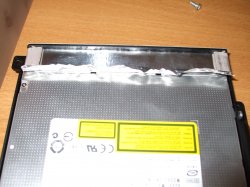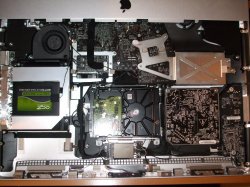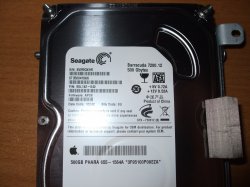This Process is the same for both the 27" and 21.5" iMac.
I have been wanting to upgrade my iMac 21.5" to a SSD drive in the optical bay for a while. Apple finally got my replacement iMac to me yesterday and I got to work...
The Slimline SATA Connection used for the SuperDrive is Sata II not Sata I. (It's the same speed as the Hard Drive SATA connection)
My OCZ Agility 128GB SSD has no problem utilising sleep connected via the SuperDrive SATA.
If anyone wishes to use a DualBoot setup then I have experienced the following:
If you try and use a USB Thumb Drive to install Windows 7 then you will need to download and install rEFIt: http://www.refit.sourceforge.net/
If you try and install Windows 7 with the SSD situated in the optical bay rEFIt will refuse to load the installer.
To overcome this issue format the original HDD in the iMac as free space using the DVD that came with your iMac purchase - Place the SSD in place of the hard drive and install OS X and Windows 7 as you normally would. Then proceed to follow the guide.
I TAKE NO RESPONSIBILITY FOR ANY DAMAGE CAUSED TO YOUR MACHINE AS A RESULT OF FOLLOWING THIS GUIDE.
The following tools will be required:
T10 Torx Screwdriver or an Allen Key if you don't have a Torx.
2 Suction cups
T0 Posidrive Screwdriver (Eyeglasses Size)
The following Parts will be required:
A SSD drive - pick a flavour. I recommend from experience the OCZ Agility 128GB or the Intel X-25m G2.
An optical bay for that precious SSD Drive (We are not doing this in a tape and cable tie manner)
This is the optical bay I used and it is a winner, has a slimline sata to standard sata built in so no need for adapters - Great price and 2 day shipping to the UK - http://newmodeus.com/shop/index.php?main_page=product_info&cPath=2_27&products_id=260
Now for the dissasembly:
Step 1
Unplug all cables and press the power button on the iMac for 30 seconds.
With the iMac still upright place a suction cup in each upper corner.
Gently pull one corner until it is clear from the magnets that hold it in place.
Proceed to pull the other corner until it is also free. With the Glass at a 45 degree angle pull upwards so the tabs at the bottom of the glass slide away from the bottom chin.
Place the Glass flat on a towel or similar to prevent the spread of dust.
Step 2
You will now have complete access to the Screen and iSight. Lay the iMac on it's back so you have easy access to the internals.
![DSCF1141.jpg DSCF1141.jpg]()
Notice that Screws are present on all 3 sides of the Display, we will only be unscrewing 8 Screws in total - 4 from the left of the display, 4 from the right.
This can be a little awkward, best practice is to take your time and if a screw does drop inside the iMac don't worry as you can reclaim it once the display is removed.
Once unscrewed the display will simply lift from the top edge (iSight side) about 30 degrees.
Look under the Display to notice a black flat cable attached to the board. This is the backlight sync cable and simply pulls horizontally away from the board.
The next cable is the LED Backlight cable and is unplugged by pressing down on the connector and pushing, again horizontally from the board.
You can now raise the Display slightly.
The next cable is the Temperature sensor. This consists of 2 thin wires joined to a connector. The connector pulls horizontally away from the board.
The last cable is the Displayport and it's a rather wide, delicate and flat black cable. Either side of the connector is a notch which when squeezed unhooks.
The screen is now free of cables and will lift higher. Once clear pull towards you so the bottom slides out of the iMacs chin and the screen is ready to be placed downwards onto a towel or similar.
Step 3:
![DSCF1135.jpg DSCF1135.jpg]()
The superdrive is attached via 4 screws. Firstly peel away the black soft foam Square which covers a Temp Sensor. Stick the Square somewhere safe and gently lift the sensor away from the superdrive and stick to the inside somewhere for now.
Proceed to unscrew all 4 screws and gently lift the back of the drive to pull the slimline sata connector out of the drive.
Once the superdrive is clear you will notice that it is attached on both sides via a total of 4 screws. Proceed to unscrew them and also peel away the aluminium tape slightly from the drive.
![DSCF1138.jpg DSCF1138.jpg]()
The superdrive is now free. Place your assembled optical bay caddy in place of the drive and re-stick the aluminium tape by pressing down firmly.
![DSCF1139.jpg DSCF1139.jpg]()
Follow the above in reverse remembering to re-stick the sensor on the SSD with the foam black square.
Step 4:
Take the Display and place it back into the chin of the iMac. Re-attach the cables in reverse order (Backlight Sync cable, Led Backlight Cable, Temperature Cable and lastly the DisplayPort Cable)
REMEMBER THE DISPLAYPORT CABLE IS DELICATE BE PATIENT AND GENTLE
Once all connected place the screen flat and proceed to replace the 8 screws.
Using Canned Air or simply the Apple iMac Cleaning Cloth wipe or blast the screen with compressed air.
Using the suction cups pick up the Glass and wipe/blast with air.
Position the bottom tabs into the chin of the iMac and move the Glass toward the iMac until magnetism takes over and "Sucks" it back into place.
Congratulations you have successfully replaced the SuperDrive with a SSD.
Proceed to install Snow Leopard via USB DVD Drive or via USB Drive.
--------------------------------------------------------------------------------------
If the Original Hard drive in the iMac is replaced then you will notice the fans get up to a high RPM very quickly and will stay at this level. This is due to a Tempreture Sensing cable attached to the original drive, at present most people simply short the cable with a peice of wire. I personally wanted to find away around this....
The Seagate Drives that come with some iMacs are standard Barracuda Drives, i.e the connection at the bottom of the Drive for the Temperature Sensor will be on the same Model range (500GB, 1TB, 1.5TB and 2TB) The only difference is the apple firmware and the sticker on the drive. For some reason Apple has added a Q to the drive model under System Profile (About this Mac, more info). The sticker on the drive does not have the Q and uses a standard Barracuda model number.
![DSCF1120.jpg DSCF1120.jpg]()
This means that the Drive can be swapped for a larger drive without shorting the temperature sensor.
I have been wanting to upgrade my iMac 21.5" to a SSD drive in the optical bay for a while. Apple finally got my replacement iMac to me yesterday and I got to work...
The Slimline SATA Connection used for the SuperDrive is Sata II not Sata I. (It's the same speed as the Hard Drive SATA connection)
My OCZ Agility 128GB SSD has no problem utilising sleep connected via the SuperDrive SATA.
If anyone wishes to use a DualBoot setup then I have experienced the following:
If you try and use a USB Thumb Drive to install Windows 7 then you will need to download and install rEFIt: http://www.refit.sourceforge.net/
If you try and install Windows 7 with the SSD situated in the optical bay rEFIt will refuse to load the installer.
To overcome this issue format the original HDD in the iMac as free space using the DVD that came with your iMac purchase - Place the SSD in place of the hard drive and install OS X and Windows 7 as you normally would. Then proceed to follow the guide.
I TAKE NO RESPONSIBILITY FOR ANY DAMAGE CAUSED TO YOUR MACHINE AS A RESULT OF FOLLOWING THIS GUIDE.
The following tools will be required:
T10 Torx Screwdriver or an Allen Key if you don't have a Torx.
2 Suction cups
T0 Posidrive Screwdriver (Eyeglasses Size)
The following Parts will be required:
A SSD drive - pick a flavour. I recommend from experience the OCZ Agility 128GB or the Intel X-25m G2.
An optical bay for that precious SSD Drive (We are not doing this in a tape and cable tie manner)
This is the optical bay I used and it is a winner, has a slimline sata to standard sata built in so no need for adapters - Great price and 2 day shipping to the UK - http://newmodeus.com/shop/index.php?main_page=product_info&cPath=2_27&products_id=260
Now for the dissasembly:
Step 1
Unplug all cables and press the power button on the iMac for 30 seconds.
With the iMac still upright place a suction cup in each upper corner.
Gently pull one corner until it is clear from the magnets that hold it in place.
Proceed to pull the other corner until it is also free. With the Glass at a 45 degree angle pull upwards so the tabs at the bottom of the glass slide away from the bottom chin.
Place the Glass flat on a towel or similar to prevent the spread of dust.
Step 2
You will now have complete access to the Screen and iSight. Lay the iMac on it's back so you have easy access to the internals.

Notice that Screws are present on all 3 sides of the Display, we will only be unscrewing 8 Screws in total - 4 from the left of the display, 4 from the right.
This can be a little awkward, best practice is to take your time and if a screw does drop inside the iMac don't worry as you can reclaim it once the display is removed.
Once unscrewed the display will simply lift from the top edge (iSight side) about 30 degrees.
Look under the Display to notice a black flat cable attached to the board. This is the backlight sync cable and simply pulls horizontally away from the board.
The next cable is the LED Backlight cable and is unplugged by pressing down on the connector and pushing, again horizontally from the board.
You can now raise the Display slightly.
The next cable is the Temperature sensor. This consists of 2 thin wires joined to a connector. The connector pulls horizontally away from the board.
The last cable is the Displayport and it's a rather wide, delicate and flat black cable. Either side of the connector is a notch which when squeezed unhooks.
The screen is now free of cables and will lift higher. Once clear pull towards you so the bottom slides out of the iMacs chin and the screen is ready to be placed downwards onto a towel or similar.
Step 3:

The superdrive is attached via 4 screws. Firstly peel away the black soft foam Square which covers a Temp Sensor. Stick the Square somewhere safe and gently lift the sensor away from the superdrive and stick to the inside somewhere for now.
Proceed to unscrew all 4 screws and gently lift the back of the drive to pull the slimline sata connector out of the drive.
Once the superdrive is clear you will notice that it is attached on both sides via a total of 4 screws. Proceed to unscrew them and also peel away the aluminium tape slightly from the drive.

The superdrive is now free. Place your assembled optical bay caddy in place of the drive and re-stick the aluminium tape by pressing down firmly.

Follow the above in reverse remembering to re-stick the sensor on the SSD with the foam black square.
Step 4:
Take the Display and place it back into the chin of the iMac. Re-attach the cables in reverse order (Backlight Sync cable, Led Backlight Cable, Temperature Cable and lastly the DisplayPort Cable)
REMEMBER THE DISPLAYPORT CABLE IS DELICATE BE PATIENT AND GENTLE
Once all connected place the screen flat and proceed to replace the 8 screws.
Using Canned Air or simply the Apple iMac Cleaning Cloth wipe or blast the screen with compressed air.
Using the suction cups pick up the Glass and wipe/blast with air.
Position the bottom tabs into the chin of the iMac and move the Glass toward the iMac until magnetism takes over and "Sucks" it back into place.
Congratulations you have successfully replaced the SuperDrive with a SSD.
Proceed to install Snow Leopard via USB DVD Drive or via USB Drive.
--------------------------------------------------------------------------------------
If the Original Hard drive in the iMac is replaced then you will notice the fans get up to a high RPM very quickly and will stay at this level. This is due to a Tempreture Sensing cable attached to the original drive, at present most people simply short the cable with a peice of wire. I personally wanted to find away around this....
The Seagate Drives that come with some iMacs are standard Barracuda Drives, i.e the connection at the bottom of the Drive for the Temperature Sensor will be on the same Model range (500GB, 1TB, 1.5TB and 2TB) The only difference is the apple firmware and the sticker on the drive. For some reason Apple has added a Q to the drive model under System Profile (About this Mac, more info). The sticker on the drive does not have the Q and uses a standard Barracuda model number.

This means that the Drive can be swapped for a larger drive without shorting the temperature sensor.
Last edited:

